Immunity Innate and Acquired Learning objectives By the

Immunity – (Innate and Acquired)

Learning objectives By the end of this session student will be able to Define innate immunity, acquired immunity To understand cells involved in innate and acquired immunity

IMMUNITY The term 'immunity' (Latin word ‘immunitas’, means freedom from disease) is defined as resistance offered by the host against microorganism(s) or any foreign substance(s). Immunity o Innate can be broadly classified into two types- immunity- present right from the birth o Acquired / Adaptive- acquired during the course of the life


Immunity

Differences between innate and acquired immunity Innate immunity Acquired / Adaptive immunity Resistance to infection that an individual possesses since birth Resistance to infection that an individual acquires during his lifetime Immune response occurs in minutes Immune response occurs in days Prior exposure to the antigen is not required Develops following the antigenic exposure Diversity is limited, acts through a restricted set of reactions More varied and specialized responses

Differences between innate and acquired immunity Innate immunity Acquired / Adaptive immunity Immunological memory responses are absent Immunological memory responses are present Respond to microbial antigens that are not Respond to specific microbial specific to some microbe, rather shared by antigens many microbes (called as microbesassociated molecular patterns) Host cell receptors (pattern recognition Host cell receptors are specific- e. g. receptors) are non- specific – e. g. Toll-like T cell receptors and B cell receptor immunoglobulin receptors

Differences between innate and acquired immunity Innate immunity Acquired / Adaptive immunity Components of innate immunity Components of acquired Anatomical barriers such as skin and mucosa immunity Physiological barriers (e. g. body temperature) T cell Phagocytes (neutrophils, macrophages & monocytes) B cell Natural killer (NK) cells Classical complement Other Classes of lymphocytes -γδ T cells , NK-T cells, B-1 cells pathway and marginal-zone B cells Antigen presenting cells Mast cells Cytokines (IL-2, IL-4, IL-5, Dendritic cells IFN-γ) Complement pathways- alternate & mannose binding pathways Fever and inflammatory responses Normal resident flora Cytokines- TNF-α, certain interleukin (IL-1, IL-6, IL-8, IL-12, IL -16, IL-18), IFN-α, β and TGF- β Acute phase reactant proteins (APRs)

INNATE IMMUNITY Innate immunity is the inborn resistance against infections that an individual possesses right from the birth, due to his genetic or constitutional makeup. Features of innate immunity: Acts in minutes Prior microbial exposure is not required Diversity is limited Non-specific No memory

Innate immunity Type of innate immunity Explanation Examples Species immunity Innate immunity towards a microbe exhibited by all members of a given species frogs are resistant to Bacillus anthracis; while toads are susceptible. Racial immunity innate immunity confined to a particular race; may be absent in other communities Negroes of America are more susceptible to tuberculosis than the whites. Individual immunity Antimicrobial defense mechanisms that are confined to a particular individual; may not be exhibited by others. One exception is identical twins

Factors influencing innate immunity Age Very old or very young more susceptible to infectious disease Hormone Endocrine disorders such as Diabetes Mellitus, hypothyroidism and adrenal dysfunctions – enhanced susceptibility to infection Nutrition Immune response is reduced in malnutrition patient

MECHANISMS OF INNATE IMMUNITY Receptor interaction o Following the exposure of microorganisms, several mediators of innate immunity are recruited to the site of infection. o The first step that takes place is attachment, which involves binding of the surface molecules of microorganisms to the receptors of cells of innate immunity. Microbial surface moleculeso Repeating patterns of conserved molecules which are common to most microbial surfaces; called as Microbes-associated molecular patterns (MAMPs). o Examples - peptidoglycan, lipopolysaccharides (LPS), teichoic acid and lipoproteins present on bacterial surface.

MECHANISMS OF INNATE IMMUNITY Pattern recognition receptors (PRRs)o Molecules present on the surface of host cells (e. g. phagocytes) that recognize MAMPs. o Conserved regions, encoded by germ line genes. o Toll like receptors(TLRs) - classical examples of pattern recognition receptors. There are 13 types of Toll like receptors (TLR 1 to 13). Important ones areo TLR-2 binds to bacterial peptidoglycan o TLR-3 binds to ds. RNA of viruses o TLR-4 binds to LPS of Gram negative bacteria o TLR-5 binds to flagella of bacteria o TLR-7 & 8 bind to ss. RNA of viruses o TLR-9 binds to bacterial DNA

Components of innate immunity 1. Anatomical and physiological barriers 2. Antibacterial substance in blood and tissues 3. Complement pathways 4. Inflammatory response 5. Microbial antagonism 6. Cytokines 7. Acute phase reactant proteins (APRs)

Anatomical and physiological barriers Anatomical Barrier Function Skin Barrier Mechanically prevents entry of microbes Produces sebum containing antimicrobial peptides and fatty acids Killing of microbes by intraepithelial lymphocytes Mucosal Barrier 1. Mucous membrane Prevents entry of microbes mechanically and by producing mucous which entraps microbes 2. Cilia present in the lower respiratory tract propel the microbes outside 3. Normal flora Intestinal & respiratory mucosa are lined by normal flora.

Anatomical and physiological barriers Physiological Function Barrier 1. Temperature Normal body temperature inhibits the growth of some microbes 2. Low p. H Gastric acidity inhibits most of the microbes 3. Secretory products of mucosa Saliva Enzymes in saliva damage the cell wall and cell membrane of bacteria Tears Contains lysozyme, that destroys the peptidoglycan layer in bacterial cell wall Gastric juice HCl kills microbes by its low p. H Trypsin Hydrolyse bacterial protein Bile salts Interfere with bacterial cell membrane Fatty acids Denature the bacterial proteins Spermine Present in semen, inhibits growth of Gram positive bacteria Lactoferrin Binds to iron, thus interferes with acquisition of iron by bacteria

Phagocytosis Phagocytes - neutrophils, macrophages including monocytes are the main component of innate immunity. Rapidly recruited to the infection site. Phagocytosis involves three sequential steps: o Engulfment of microbes and subsequent hosting in phagosome. o Fusion of lysosome with phagosome to form phagolysosome o Microbial killing

Cellular components of Innate immunity NK cells: Class of lymphocytes that kill virus infected cells and tumor cells. Mast cells: Present lining the respiratory and other mucosa. Activated by microbial products binding to toll like receptors or by Ig. E antibody dependent mechanism. They release abundant cytoplasmic granules rich in histamine, prostaglandins & cytokines that initiate inflammation and proteolytic enzymes that can kill bacteria Dendritic cells: Respond to microbes by producing numerous cytokines that initiate inflammation. Serve as vehicle in transporting the antigen(s) from the skin and mucosal site to lymph nodes where they present the antigen(s) to T cells - bridge between innate and acquired immunity.

Complement pathways Alternate complement pathway is activated in response to bacterial endotoxin. Mannose binding pathway is stimulated by mannose carbohydrate residues on bacterial surface. Biological function; Lysis of the target microbes (by forming pores on the microbial surfaces) Stimulate inflammation (by secreting inflammatory mediators) Stimulate acquired immunity- Complements are another bridge between innate and acquired immunity.

Inflammatory response Vasodilation Leakage of plasma proteins through blood vessels Recruitment of phagocytes (e. g. neutrophils) to the site of inflammation Engulfment of microbes and dead material by the phagocytes Destruction of the microbes

Normal resident flora: Microbial antagonism Ø Compete with the pathogens for nutrition. Produce antibacterial substances. Ø Alteration in bacterial flora – leads to invasion by extraneous microbes Ø Followed by oral antibiotics

Cytokines In response to the microbial antigens, dendritic cells, macrophages, and other cells secrete several cytokines that mediate many of the cellular reactions of innate immunity such as: o Tumor necrosis factor (TNF), o Interleukin-1 (IL-1), IL-6, IL-8, IL-10 & IL-16 o Interferons (IFN-α, β) and o Transforming growth factor (TGF-β)

Acute phase reactant proteins (APRs) Proteins synthesized by liver at steady concentration, but their synthesis either increases or decreases exponentially during acute inflammatory conditions. APRs can also be synthesized by various other cells such as endothelial cells, fibroblasts, monocytes and adipocytes. APRs have various antimicrobial and anti-inflammatory activities (e. g. complement factors)

Positive APRs Proteins whose levels increase during acute inflammation. Examples includeo Serum Amyloid A o C- Reactive protein o Complement proteins – Complement factors (C 1 -C 9), factor B, D, and properdin o Coagulation protein- e. g. fibrinogen, von-willebrand factor o Proteinase inhibitors- e. g. α 1 antitrypsin o α 1 acid glycoprotein o Mannose binding protein o Haptoglobin o Metal binding proteins- e. g. Ceruloplasmin

Negative APRs Proteins whose levels are decreased during acute inflammation thus creating a negative feedback that stimulates the liver to produce positive APRs. Examples of negative APRs include: o Albumin o Transferrin o Anti-thrombin.

C- Reacting protein (CRP) CRP belongs to beta globulin family. CRP is so named because it precipitates with C- carbohydrate (polysaccharide) antigen of Pneumococcus. CRP not an antibody against the C- carbohydrate antigen of Pneumococcus; it is nonspecific, can be raised in any inflammatory conditions. Commonest markers of acute inflammation, used in most diagnostic laboratories.

C- Reacting protein (CRP) Normal level - <0. 2 mg/dl. Increases by several folds in acute inflammatory conditions: o Insignificant increase (<1 mg/dl) –heavy exercise, common cold, and pregnancy o Moderate increase (1 -10 mg/dl )- bronchitis, cystitis, malignancies, pancreatitis, myocardial infarction o Marked increase (>10 mg/dl)- acute bacterial infections, major trauma and systemic vasculitis

Detection of CRP Precipitation method using C carbohydrate antigen (obsolete, not in use now) Latex (passive) agglutination test using latex particles coated with anti-CRP antibodies -most widely used. Detection limit of CRP by latex agglutination test – 0. 6 mg/dl Highly sensitive CRP (hs-CRP)test Minute quantities of CRP can be detected by various methods (e. g. nephelometry, enzyme immunoassays). Useful in assessing the risk to cardiovascular diseases

Acquired Immunity

PROPERTIES OF ACQUIRED IMMUNITY Mediators- T cells & B cells are the chief mediators of acquired immunity. Others includeo Classical complement pathway o Antigen presenting cells o Cytokines (IL-2, IL-4, IL-5) Response occurs in days - It requires the activation of T and B cells against the microbial antigens. Requires prior microbial exposure- Acquired immunity develops only after the exposure to the microbes.

PROPERTIES OF ACQUIRED IMMUNITY Specific-Acquired immunity is highly specific; directed against specific antigens that are unique to the microbes. Memory present- A proportion of T and B cells become memory cells following primary contact of the microbe, which play an important role when the microbe is encountered subsequently. Diversity is wide- Acquired immunity though takes time to develop is active against a wide range of repertoire of antigens. Host cell receptors of acquired immunity are specific for particular microbial antigeno Examples include-T cell receptors and B cell immunoglobulin receptors

Types of Acquired immunity Active and passive immunity Artificial and natural immunity

Differences between active and passive immunity Active immunity Passive immunity Produced actively by host immune system Induced by Infection (natural) Vaccination (artificial) Immunoglobulins received passively Long lasting Lasts for short time Lag period present No Lag period Memory present No Memory Booster doses-useful Subsequent doses-Less effective Negative phase may occur No Negative phase In immunodeficiency individuals not useful Useful in immunodeficient individuals Acquired by Mother to fetus Ig. G transfer (natural) Readymade antibody transfer (artificial)

ACTIVE IMMUNITY Active immunity is the resistance developed by an individual towards an antigenic stimulus. Active immunity may be induced naturally or artificially: o Natural active immunity (e. g. measles virus infection) o Artificial active immunity (e. g. measles vaccine).

ACTIVE IMMUNITY Long-lasting- Active immunity usually lasts for longer periods but the duration varies depending on the type of pathogen. o Last life long- e. g. following certain viral infections such as chicken pox, measles, small pox, mumps and rubella. o Last short- e. g. following influenza infection. o Premunition or concomitant immunity – Immunity may last as long as the microbe is present. Once the disease is cured, the patient becomes susceptible to the microbe again (Spirochaetes and Plasmodium).

ACTIVE IMMUNITY o Premunition or concomitant immunity – Immunity may last as long as the microbe is present. Once the disease is cured, the patient becomes susceptible to the microbe again (Spirochaetes and Plasmodium). o Active immunity may not be protective at all- e. g. for Haemophilus ducreyi, the patient may develop genital lesions following reinfection even while the original infection is active.
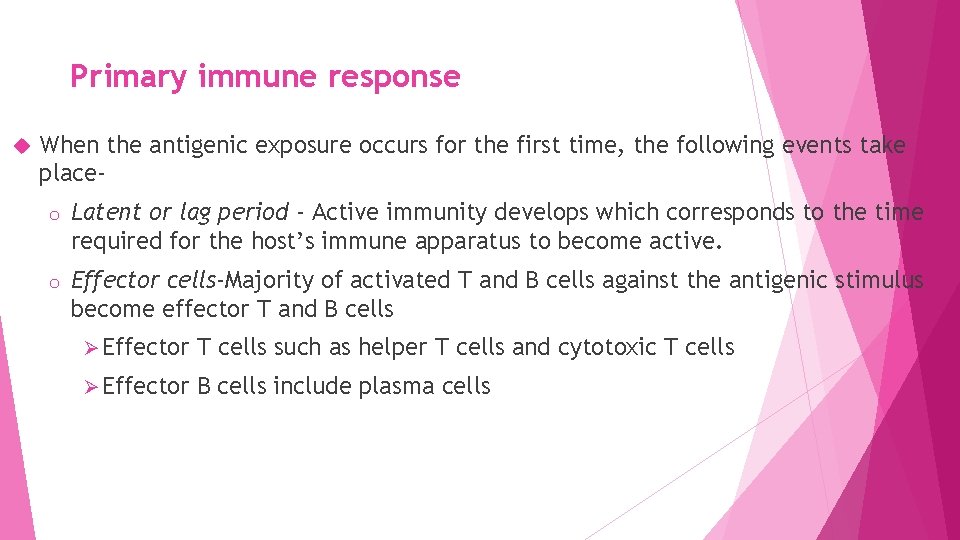
Primary immune response When the antigenic exposure occurs for the first time, the following events take placeo Latent or lag period - Active immunity develops which corresponds to the time required for the host’s immune apparatus to become active. o Effector cells-Majority of activated T and B cells against the antigenic stimulus become effector T and B cells Ø Effector T cells such as helper T cells and cytotoxic T cells Ø Effector B cells include plasma cells

Primary immune response o Memory cells- A minor proportion of stimulated T and B cells become memory cells, which are the key cells for secondary immune response. o Antibody surge Ø Activated B cells produce antibodies (mainly Ig. M type). Ø Antibodies appear in the serum in slow & sluggish manner; reach peak, maintain the level for a while and then fall down. Ø Finally, serum. a low titer of baseline antibodies may be maintained in the
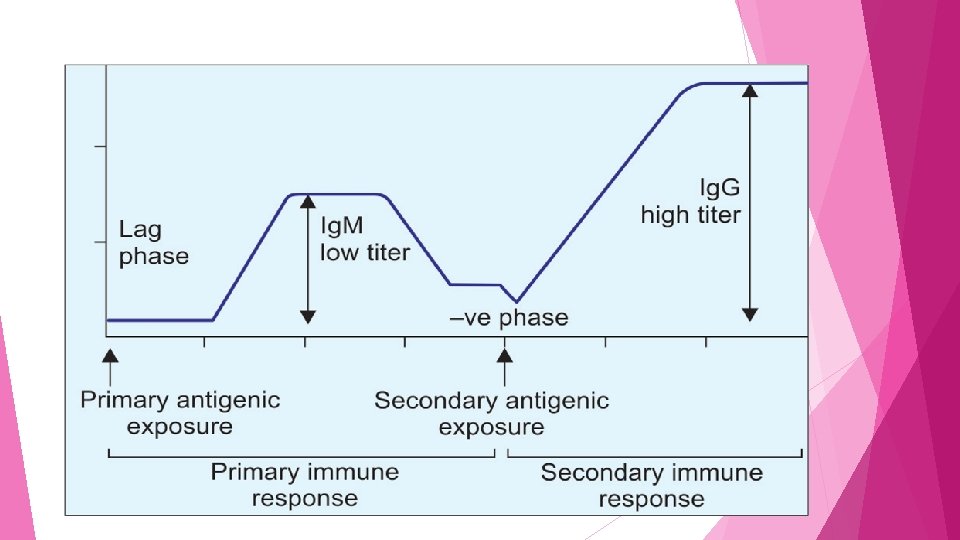

Secondary immune response When the same antigenic exposure occurs subsequently, the events which take place are as follows: o Latent period o Negative phase o Antibody surge
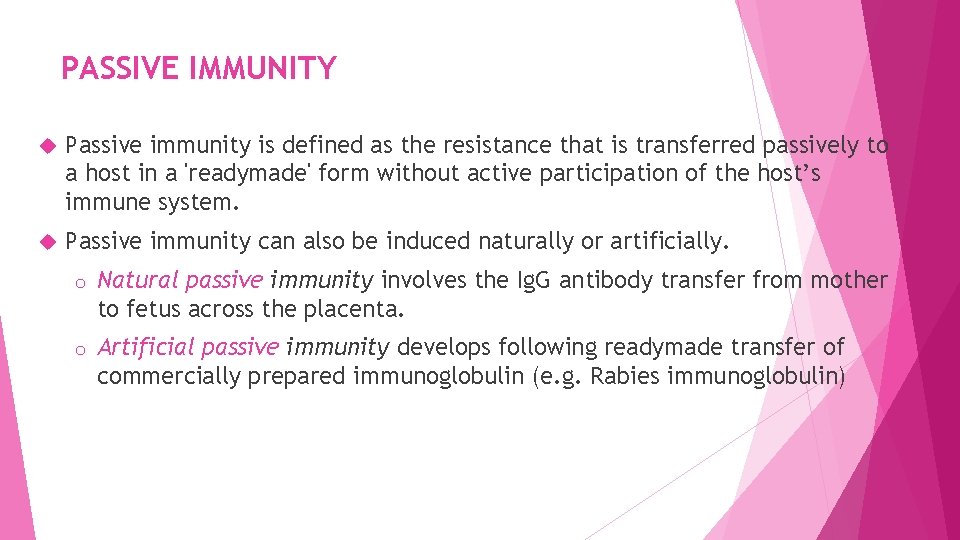
PASSIVE IMMUNITY Passive immunity is defined as the resistance that is transferred passively to a host in a 'readymade' form without active participation of the host’s immune system. Passive immunity can also be induced naturally or artificially. o Natural passive immunity involves the Ig. G antibody transfer from mother to fetus across the placenta. o Artificial passive immunity develops following readymade transfer of commercially prepared immunoglobulin (e. g. Rabies immunoglobulin)
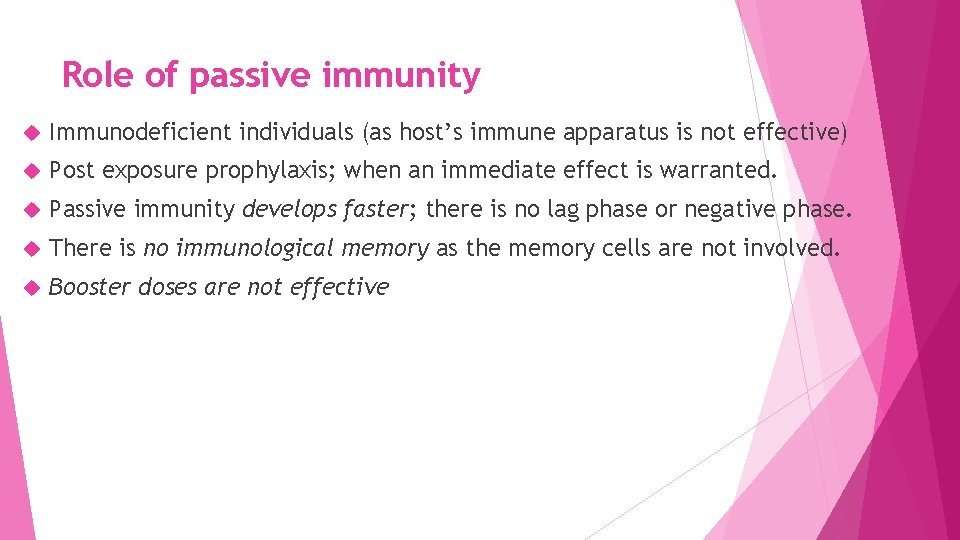
Role of passive immunity Immunodeficient individuals (as host’s immune apparatus is not effective) Post exposure prophylaxis; when an immediate effect is warranted. Passive immunity develops faster; there is no lag phase or negative phase. There is no immunological memory as the memory cells are not involved. Booster doses are not effective

Differences between Primary and Secondary immune response Primary immune response Secondary immune response Immune response against primary antigenic Immune response against subsequent challenge antigenic challenge Slow, sluggish (appear late) and short lived Prompt, powerful & prolonged (long lasting) Lag period is longer (4 -7 days) Lag period is absent or short (1 -3 days) No negative phase Negative phase may occur Antibody produced in low titer & is of Ig. M type. Antibodies are more specific but less avid Antibody produced in high titer & is of Ig. G type Antibodies are less specific but more avid Antibody producing cells- Naive B cells Antibody producing cells- Memory B cells Both T dependent and T independent antigens are processed. Only T dependent antigens are processed.
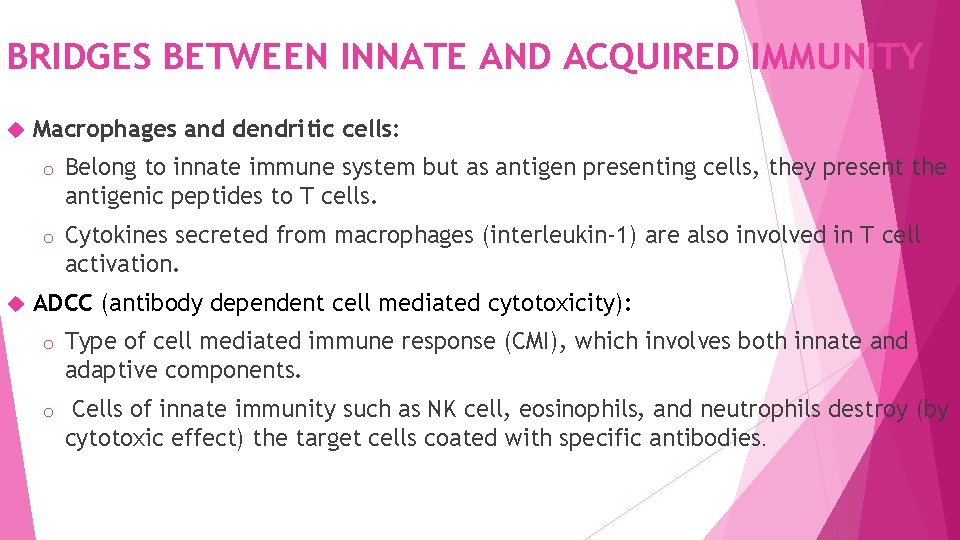
BRIDGES BETWEEN INNATE AND ACQUIRED IMMUNITY Macrophages and dendritic cells: o Belong to innate immune system but as antigen presenting cells, they present the antigenic peptides to T cells. o Cytokines secreted from macrophages (interleukin-1) are also involved in T cell activation. ADCC (antibody dependent cell mediated cytotoxicity): o Type of cell mediated immune response (CMI), which involves both innate and adaptive components. o Cells of innate immunity such as NK cell, eosinophils, and neutrophils destroy (by cytotoxic effect) the target cells coated with specific antibodies.

BRIDGES BETWEEN INNATE AND ACQUIRED IMMUNITY Complements (classical pathway) o Part of both innate and adaptive immunity. o Destroy the target cells which are coated with specific antibodies. o Alternate and mannose binding pathways do not take help of antibodies. Cytokines o Secreted from cells of innate immunity can activate cells of adaptive immunity and vice versa. o E. g. IL-1 secreted from macrophage activates helper T cells and interferon-γ secreted by helper T cell can activate macrophage.

BRIDGES BETWEEN INNATE AND ACQUIRED IMMUNITY Rare classes of lymphocytes such as γδ T cells , NK-T cells, B-1 cells and Marginal-zone B cells. o These cells have many characteristics that place them in the border of innate & acquired immunity. o Function in the early defense against microbes as part of innate immunity. o Although their receptors are encoded by somatic recombination of genes (similar to that of classical T and B cells), but these receptors have limited diversity. o Develop a memory phenotype in contrast to the property of innate immunity.

Local (or mucosal) immunity Immune response that is active at the mucosal surfaces such as intestinal or respiratory or genitourinary mucosa. Mediated by a type of Ig. A antibody called secretory Ig. A. Local immunity can only be induced by natural infection or by live vaccination (but not by killed vaccines).
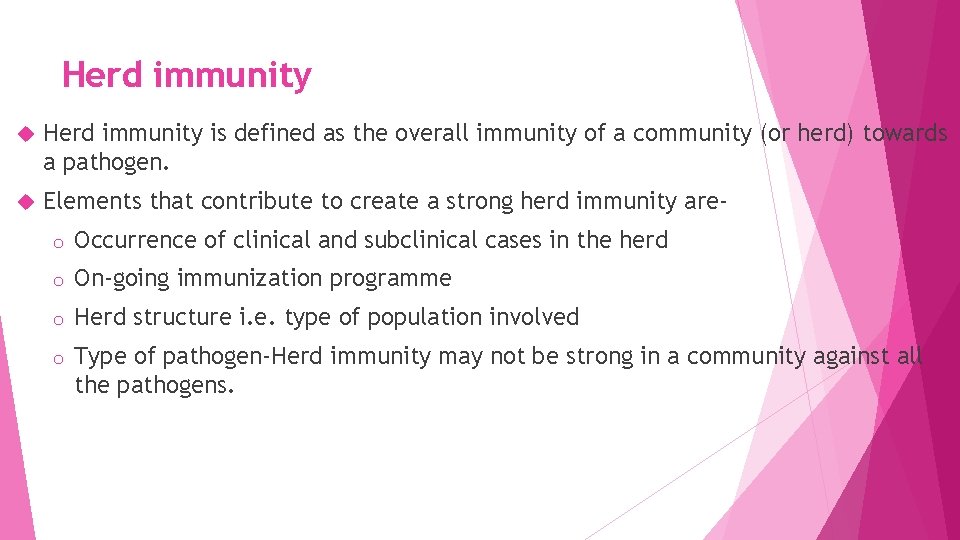
Herd immunity is defined as the overall immunity of a community (or herd) towards a pathogen. Elements that contribute to create a strong herd immunity areo Occurrence of clinical and subclinical cases in the herd o On-going immunization programme o Herd structure i. e. type of population involved o Type of pathogen-Herd immunity may not be strong in a community against all the pathogens.
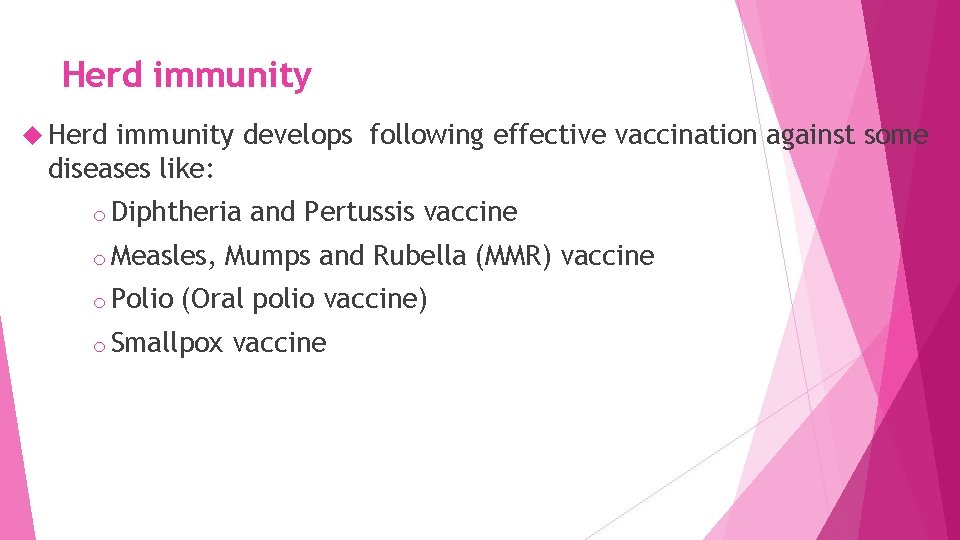
Herd immunity develops following effective vaccination against some diseases like: o Diphtheria o Measles, o Polio and Pertussis vaccine Mumps and Rubella (MMR) vaccine (Oral polio vaccine) o Smallpox vaccine

Adoptive immunity Special type of cell mediated immune response (CMI) which develops following injection of immunologically competent T-lymphocytes known as Transfer factor. Useful for treatment when the CMI is low- e. g. in lepromatous leprosy.

THANK YOU
- Slides: 51